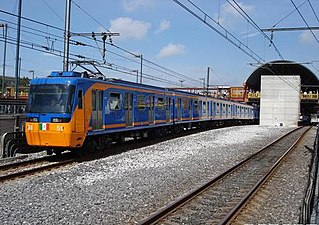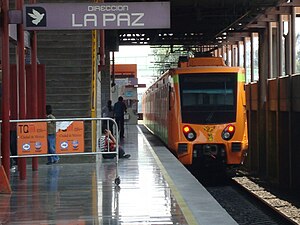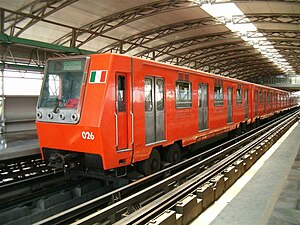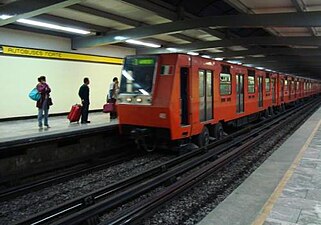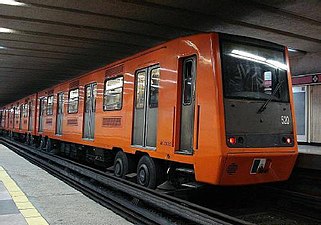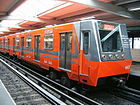Mexico City Metro
| Mexico City Metro | |||
|---|---|---|---|
 | |||
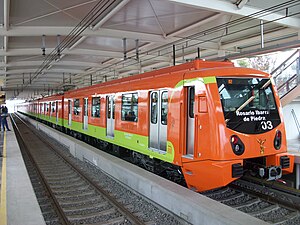 | |||
| Overview | |||
| Native name | Sistema de Transporte Colectivo - Metro | ||
| Owner | Mexico City Government | ||
| Area served | Greater Mexico City | ||
| Locale | Mexico City | ||
| Transit type | Rapid transit | ||
| Number of lines | 12[1] | ||
| Line number | 1-9, 12, A, B | ||
| Number of stations | 195[1] | ||
| Daily ridership | 4,534,383 (2019)[2] | ||
| Annual ridership | 1.655 billion (2019)[2] | ||
| Chief executive | Guillermo Calderón Aguilera | ||
| Website | Metro de la Ciudad de México | ||
| Operation | |||
| Began operation | 4 September 1969[3] | ||
| Operator(s) | Sistema de Transporte Colectivo (STC) | ||
| Number of vehicles | 390[4] | ||
| Technical | |||
| System length | 200.9 km (124.8 mi) in revenue service; (226.5 km (140.7 mi) considering maintenance tracks)[5] | ||
| Track gauge | 1,435 mm(4 ft8+1⁄2in)standard gauge (2 lines); androll waysalong the outside of conventional standard gauge track (Rubber-tired metro) (10 lines) | ||
| |||
TheMexico City Metro(Spanish:Metro de la Ciudad de México) is arapid transitsystem that servesthe metropolitan areaofMexico City,including some municipalities in theState of Mexico.Operated by theSistema de Transporte Colectivo(STC), it is thesecond largest metro system in North Americaafter theNew York City Subway.
The inaugural STC Metro line was 12.7 kilometres (7.9 mi) long, serving 16 stations, and opened to the public on 4 September 1969.[3]The system has expanded since then in a series of fits and starts. As of 2015[update],the system has 12 lines,[1]serving 195 stations,[1]and 226.49 kilometres (140.73 mi) of route.[1]Ten of the lines arerubber-tired.Instead of traditional steel wheels, they usepneumatictraction, which is quieter and rides smoother in Mexico City's unstable soils. The system survived the1985 Mexico City earthquake.[6]
Of the STC Metro's195 stations,[1]44 serve two or more lines (correspondenciasortransfer stations).[7]Many stations are named for historical figures, places, or events in Mexican history. It has 115 underground stations[1](the deepest of which are 35 metres [115 ft] below street level); 54 surface stations[1]and 26 elevated stations.[1]All lines operate from 5 a.m. to midnight.[citation needed]At the end of 2007, theFederal Districtgovernment announced the construction of the most recent STC Metro line, Line 12, which was built to run approximately 26 kilometres (16 mi)[8]towards the southeastern part of the city, connecting with Lines 7, 3, 2 and 8. This line opened on 30 October 2012.[9]
History[edit]
Concept of the Metro and early plans[edit]

By the second half of the twentieth century,Mexico Cityhad serious public transport issues, with congested main roads andhighways,especially in thedowntownzone, where 40 percent of the daily trips in thecitywere concentrated. 65 of the 91 lines ofbusand electric transport served this area. With four thousand units in addition to 150,000 personalautomobilepeak hours, the average speed was less than walking pace.
The principal promoter of the construction of the Mexico City Metro was engineerBernardo Quintana,who was in charge of the construction company Ingenieros Civiles y Asociados (Civil Engineers and Associates). He carried out a series of studies that resulted in a draft plan which would ultimately lead to the construction of the Mexico City Metro. This plan was shown to different authorities of Mexico City but it was not made official until 29 April 1967, when the Government Gazette ("Diario Oficial de la Federación") published the presidential decree that created a public decentralized organism, theSistema de Transporte Colectivo,with the proposal to build, operate and run anundergroundrapid transitnetwork as part of Mexico City's public transport system.[10]
The Mexico City Metro benefited from a great amount of technical assistance made available by France.RATP'sengineering branchSOFRETUplayed a major role in its initial planning and the design of the first lines, hence the choice of tyre/rail technology.
On 19 June 1967, at the crossroads of Chapultepec Avenue withAvenida Bucareli,the inauguration ceremony for the Mexico City Metro took place. Two years later, on 4 September 1969, an orange train made the inaugural trip betweenZaragozaandInsurgentesstations, thus beginning daily operation up to today.[11]


First stage (1967–1972)[edit]
The first stage of construction comprised the construction, done byGrupo ICA,and inauguration of lines 1, 2 and 3. This stage involved engineers, geologists, mechanics, civil engineers, chemists, hydraulic and sanitation workers, electricians, archaeologists, and biologists; specialists in ventilation, statistics, computation, and in traffic and transit; accountants, economists, lawyers, workers and laborers. Between 1,200 and 4,000 specialists and 48,000 workers participated, building at least one kilometre (0.62 mi) of track per month, the fastest rate of construction ever for a subway.[citation needed]
During this stage of construction workers uncovered two archaeological ruins, one Aztec idol, and the bones of a mammoth (on display atTalismán station).[12]
By the end of the first stage, namely on 10 June 1972, the STC Metro had 48 stations and a total length of 41.41 kilometres (25.73 mi): Line 1 ran fromObservatoriotoZaragoza,Line 2 fromTacubasouthwest toTasqueñaand line 3 fromTlatelolcotoHospital Generalin the south, providing quick access to theGeneral Hospital of Mexico.
Second stage (1977–1982)[edit]
No further progress was reached during PresidentLuis Echeverría's government, but duringJosé López Portillo's administration, a second stage began. TheComisión Ejecutiva del Metro(Executive Technical Commission of Mexico City Metro) was created in order to be in charge of expanding the STC Metro within the metropolitan area of Mexico City.
Works began with the expansion of Line 3 towards the north fromTlatelolcotoLa Razain 1978 and to the current terminalIndios Verdesin 1979, and towards the south fromHospital GeneraltoCentro Médicoin 1980 and toZapatamonths later. Construction of lines 4 and 5 was begun and completed on 26 May – 30 August 1982, respectively; the former fromMartín CarreratoSanta Anitaand the latter fromPolitécnicotoPantitlán.Line 4 was the first STC Metro line built as an elevated track, owing to the lower density of big buildings.
Third stage (1983–1985), and the 1985 earthquake[edit]
This construction stage took place from the beginning of 1983 through the end of 1985. Lines 1, 2 and 3 were expanded to their current lengths, and new lines 6 and 7 were built. The length of the network was increased by 35.29 kilometres (21.93 mi) and the number of stations to 105.
Line 3's route was expanded fromZapata stationtoUniversidad stationon 30 August 1983. Line 1 was expanded fromZaragozato the current terminalPantitlán,and line 2 fromTacubato the current terminalCuatro Caminos.These last two were both inaugurated on 22 August 1984.
Line 6's route first ran fromEl RosariotoInstituto del Petróleo;Line 7 was opened fromTacubatoBarranca del Muertoand runs along the foot of the Sierra de las Cruces mountain range that surrounds theValley of Mexicoat its west side, outside of the ancient lake zone. This made it possible for Line 7 to be built as a deep-bore tunnel.
On the morning of 19 September 1985, amagnitude 8.0 earthquakestruck Mexico City. Many buildings as well as streets were left with major damage making transportation on the ground difficult, but the STC Metro was not damaged because a rectangular structure had been used instead of arches, making it resistant to earthquakes, thus proving to be a safe means of transportation in a time of crisis.[citation needed]
On the day of the quake, the Metro stopped service and completely shut down for fear of electrocution. This caused people to get out of the tunnels from wherever they were and onto the street to try to get where they were going.[13]At the time, the Metro had 101 stations, with 32 closed to the public in the weeks after the event. OnLine 1,there was no service in stationsMerced,Pino Suárez,Isabel la Católica,Salto del Agua,BalderasorCuauhtémoc.OnLine 2,there was no service between stationsBellas ArtesandTasqueña.OnLine 3onlyJuárezand Balderas were closed.Line 4continued to operate normally. All of the closed stations were in the historic center area, with the exception of the stations of Line 2 south of Pino Suárez. These stations were located above the ground. The reason these stations were closed was not due to damage to the Metro proper, but rather because of surface rescue work and clearing of debris.[14]
Fourth stage (1985–1987)[edit]
Fourth stage saw the completion of Line 6 fromInstituto del Petróleoto its eastern terminalMartín Carreraand Line 7 to the north fromTacubatoEl Rosario.Line 9 was the only new line built during this stage. It originally ran fromPantitlántoCentro Médico,and its expansion toTacubayawas completed on 29 August 1988. For Line 9, a circular deep-bore tunnel and an elevated track were used.
Fifth stage (1988–1994)[edit]
For the first time, a service line of the Mexico City Metro ran into theState of Mexico:planned as one of morelíneas alimentadoras(feeder lines to be named by letters, instead of numbers), line A was fully operational by its first inauguration on 12 August 1991. It runs fromPantitlántoLa Paz,located in the municipalityof the same name.This line was built almost entirely above ground, and to reduce the cost of maintenance, steel railway tracks andoverhead lineswere used instead ofpneumatictraction, promoting the namemetro férreo(steel-rail metro) as opposed to the previous eight lines that used pneumatic traction.
The draft for Line 8 planned acorrespondencia(transfer station) inZócalo,namely the exact center of the city, but it was canceled due to possible damage to the colonial buildings and the Aztec ruins, so it was replanned and now it runs fromGaribaldi,which is still downtown, toConstitución de 1917in the southeast of the city. The construction of line 8 began in 1988 and was completed in 1994.
With this, the length of the network increased 37.1 kilometres (23.1 mi), adding two lines and 29 more stations, giving the metro network at that point a total of 178.1 kilometres (110.7 mi), 154 stations and 10 lines.
Sixth stage (1994–2000)[edit]
Assessment forline Bbegan in late 1993. Line B was intended as a secondlínea alimentadorafor northeastern municipalities in the State of Mexico, but, unlike line A, it used pneumatic traction. Construction of thesubterraneantrack betweenBuenavista(named after the oldBuenavista train station) andGaribaldibegan in October 1994. Line B was opened to the public in two stages: from Buenavista toVilla de Aragónon 15 December 1999, and from Villa de Aragón toCiudad Aztecaon 30 November 2000.
Seventh stage (2008–2014)[edit]
Plans for a new STC Metro line started in 2008, although previous surveys and assessments were made as early as 2000. Line 12's first service stage was planned for completion in late 2009 with the creation of track connectingAxomulco,a planned new transfer station for Line 8 (betweenEscuadrón 201andAtlalilco) toTláhuac.The second stage, connectingMixcoacto Tláhuac, was to be completed in 2010.
Construction of Line 12 started in 2008, assuring it would be opened by 2011. Nevertheless, completion was delayed until 2012. Free test rides were offered to the public in some stations, and the line was fully operational on 30 October 2012. With minor changes, Line 12 runs from Mixcoac to Tláhuac, serving southern Mexico City for the first time. At 24.31 kilometres (15.11 mi) long, it is the longest line in the system.
Line 12 differs from previous lines in several aspects: nohawkersare allowed, either inside the train or inside the stations; it is the first numbered line to use steel railway tracks; one must have a Tarjeta DF smart card to access any station since Metro tickets are no longer accepted.
In the bookLos hombres del Metro,[citation needed]the original planning of Line 12 is described; although it was to begin at Mixcoac as it does today, Atlalilco and Constitución de 1917 stations of Line 8 were to be part of Line 12. The same map shows that Line 8 would have reached the Villa Coapa area and that it would not have had a terminal at Garibaldi, but at Indios Verdes, linking with Line 3. In addition, the book shows that Line 7 would have terminated at San Jerónimo. None of these plans have been confirmed by the Mexico City government.
In 2015, mayorMiguel Ángel Manceraannounced the construction of two more stations and a terminal for Line 12:Valentín Campa,[15]Álvaro ObregónandObservatorio,both west ofMixcoac.With this, Line 12 is to be connected to Line 1, providing new metro access to the Observatorio zone, which will become the terminal for theintercity trainbetween Mexico City andToluca.[16][17]
Archaeological finds[edit]
The metro system's construction has resulted in more than 20 thousand archeological finds, from various time periods in the history of theindigenous people.[18]The excavations needed to make way for the rails gave opportunities to findartifactsfrom different periods of the region's inhabitants, in areas that are now densely urbanized.[citation needed]Objects and small structures were found, with origins spanning from prehistoric times to the 20th century. Some examples of artifacts preserved by the Mexican National Institute of Anthropology and History (Instituto Nacional de Antropología e Historiade México (INAH)) are: parts of pyramids (like an altar to theMexicagodEhecatl), a sculpture of the goddessCoatlicue,and remains of amammoth.[19]The altar to Ehécatl is now in Pino Suárez station, betweenlines 1 and 2,and is called by the INAH the smallest archeological site in Mexico. The metro has led to a large quantity of archeological finds, and has also let archaeologists understand more about the pattern of ancient civilisations in the Mexican capital by analysing its underground from various time periods.
Architecture[edit]
Distinguished architects were hired to design and construct the stations on the first metro line, such asEnrique del Moral,Félix Candela,Salvador Ortega andLuis Barragán.Examples of Candela's work can be seen inSan Lázaro,Candelaria,andMercedstations on Line 1.[citation needed]
Cultural References[edit]
The Metro has figured in Mexico's cultural history, as the inspiration for a musical composition for strings, "Metro Chabacano"[20]andRodrigo "Rockdrigo" González's 1982 song, "Metro Balderas".It was also a filming location for the 1990 Hollywood movieTotal Recall.[21]Public intellectualCarlos Monsiváishas commented on the cultural importance of the Metro, "a space for collective expression, where diverse social sectors are compelled to mingle every day".[22]
Lines, stations, names, colors, and logos[edit]




Each line offers one service only, and to each line, a number (letter if feeding line) and color are assigned. Every assigned color is present on square-shaped station logos, system maps and street signs, and neither colors nor numbers have been changed. Line B is the only exception to the color assignment, as green (upper half) and grey (lower half) are used, producing thus bicolor logos and signs. Gray only may be used to avoid confusion with line 8, which uses a similar green.
The names of metro stations are often historical in nature, highlighting people, places, and events in Mexican history. There are stations commemorating aspects of theMexican Revolutionand the revolutionary era. When it opened in 1969 with line 1 (the "Pink Line" ), two stations alluded to the Revolution. Most directly referencing the Revolution wasPino Suárez,named afterFrancisco I. Madero'svice president,who was murdered with him in February 1913. The other wasBalderas,whose icon is a cannon, alluding to the Ciudadela armory where the coup against Madero was launched. In 1970,Revoluciónopened, with the station at theMonument to the Revolution.As the Metro expanded, further stations with names from the revolutionary era opened. In 1980, two popular heroes of the Revolution were honored, withZapataexplicitly commemorating the peasant revolutionary from Morelos. A sideways commemoration wasDivisión del Norte,named after the Army thatPancho Villacommanded until its demise in theBattle of Celayain 1915.
The year 1987 saw the opening of theLázaro Cárdenasstation. In 1988,Aquiles Sedánhonorsthe first martyr of the Revolution.In 1994,Constitución de 1917opened, as didGaribaldi,named after the grandson of Italian fighter for independence,Giuseppe Garibaldi.The grandson had been a participant in the Mexican Revolution. In 1999, the radical anarchistRicardo Flores Magónwas honored with thestation of the same name.Also opening in 1999 wasRomero Rubio,named afterthe leaderofPorfirio Díaz'sCientíficos,whose daughter, Carmen Romero Rubio, became Díaz's second wife.[23]In 2012, a new Metro line opened with anHospital 20 de Noviembrestop, a hospital named after the date thatFrancisco I. Maderoin his 1910Plan de San Luis Potosícalled for rebellion against Díaz. There are no Metro stops named for Madero, Carranza, Obregón, or Calles, and only an oblique reference to Villa in Metro División del Norte.
Each station is identified by a minimalist logo, first designed byLance Wyman,who had also designed the logo for the1968 Mexico Olympics.[24]Logos are generally related to the name of the station or the area around it. At the time of Line 1's opening, Mexico'silliteracyrate was high.[25][26]As of 1960, 38% of Mexicans over the age of five were illiterate and only 5.6% of Mexicans had completed elementary school.[27]Since one-third of the Mexican population could not read or write and most of the rest had not completed high school, it was thought that patrons would find it easier to guide themselves with a system based on colors and visual signs.[citation needed]
The logos are not assigned at random; rather, they are designated by considering the surrounding areas, such as:
- The reference places that are located around the stations (e.g., the logo forSalto del Aguafountain depicts a fountain).
- The topology of an area (e.g.,Coyoacán—inNahuatl"place of coyotes" —depicts acoyote).
- The history of the place (e.g.,Juárez,named afterPresident Benito Juárez,depicts his silhouette).
The logos' background colors reflect those of the line the station serves. Stations serving two or more lines show the respective colors of each line in diagonal stripes, as inSalto del Agua.This system was adopted for theGuadalajaraandMonterreymetros, and for theMexico City Metrobús.Although logos are no longer necessary due to literacy being now widespread, their usage has remained.
| Line | Northern/Western terminal[3] | Southern/Eastern terminal[3] | Total stations[3] | Passenger track[28] | Inauguration[3] | Ridership (2019)[2] | |
|---|---|---|---|---|---|---|---|

|
Line 1 | Observatorio(W) | Pantitlán(E) | 20 | 16.65 kilometres (10.35 mi) | 4 September 1969 | 242,787,412 |

|
Line 2 | Cuatro Caminos(N) | Tasqueña(S) | 24 | 20.71 kilometres (12.87 mi) | 1 August 1970 | 269,149,446 |

|
Line 3 | Indios Verdes(N) | Universidad(S) | 21 | 21.28 kilometres (13.22 mi) | 20 November 1970 | 222,368,257 |

|
Line 4 | Martín Carrera(N) | Santa Anita(S) | 10 | 9.36 kilometres (5.82 mi) | 29 August 1981 | 29,013,032 |

|
Line 5 | Politécnico(N) | Pantitlán(S) | 13 | 14.44 kilometres (8.97 mi) | 19 December 1981 | 86,512,999 |

|
Line 6 | El Rosario(W) | Martín Carrera(E) | 11 | 11.43 kilometres (7.10 mi) | 21 December 1983 | 49,945,822 |

|
Line 7 | El Rosario(N) | Barranca del Muerto(S) | 14 | 17.01 kilometres (10.57 mi) | 20 December 1984 | 108,152,051 |

|
Line 8 | Garibaldi / Lagunilla(N) | Constitución de 1917(S) | 19 | 17.68 kilometres (10.99 mi) | 20 July 1994 | 133,620,679 |

|
Line 9 | Tacubaya(W) | Pantitlán(E) | 12 | 13.03 kilometres (8.10 mi) | 26 August 1987 | 113,765,528 |

|
Line A | Pantitlán(W) | La Paz(E) | 10 | 14.89 kilometres (9.25 mi) | 12 August 1991 | 112,288,064 |

|
Line B | Ciudad Azteca(N) | Buenavista(S) | 21 | 20.28 kilometres (12.60 mi) | 15 December 1999 | 152,545,958 |

|
Line 12 | Mixcoac(W)[9] | Tláhuac(E)[9] | 20[9] | 24.11 kilometres (14.98 mi) | 30 October 2012[9] | 134,900,367 |
Under construction:
| Line | Northern/Western terminal | Southern/Eastern terminal | Total stations | |
|---|---|---|---|---|

|
Line 12western extension | Observatorio(W) | Mixcoac(E) | 3 |
Transfers to other systems[edit]
| Year | Ridership | % Change |
|---|---|---|
| 2002 | 1,396,408,190 | - |
| 2003 | 1,375,089,433 | -1.55% |
| 2004 | 1,441,659,626 | +4.84% |
| 2005 | 1,440,744,414 | -0.06% |
| 2006 | 1,416,995,974 | -1.65% |
| 2007 | 1,352,408,424 | -4.56% |
| 2008 | 1,460,144,568 | +7.38% |
| 2009 | 1,414,907,798 | -3.20% |
| 2010 | 1,530,352,732 | +8.16% |
| 2011 | 1,594,903,897 | +4.22% |
| 2012 | 1,608,865,177 | +0.88% |
| 2013 | 1,684,936,618 | +4.73% |
| 2014 | 1,614,333,594 | -4.19% |
| Sources:[29][30][31][32][33][34][35] | ||

The Mexico City Metro offers in and out-street transfers to four major rapid transit systems: theMexico City Metrobúsand State of MexicoMexibúsbus rapid transit systems,theMexico Citylight railsystem and theFerrocarril Suburbano (FSZMVM)commuter rail.None of these are part of the Sistema de Transporte Colectivo network and an extra fare must be paid for access.
Metrobús line 1was inaugurated in 2005. According to the 1985 STC Metro Master Plan, Metrobús Line 1 roughly follows the route planned for STC Metro Line 15 by 2010, which was never built. Every transfer is out-of-station, but the same smart card may be used for payment. All five lines (Line 5 to be built during 2013) offer a connection to at least one STC Metro station. STC Metro stations that connect to Metrobús lines includeIndios Verdes,La Raza,Chilpancingo,Balderas,Etiopía / Plaza de la Transparencia,Insurgentes Surand others.
The sole light rail line running from Tasqueña to Xochimilco is operated by theServicio de Transportes Eléctricosand is better known as Tren Ligero. Line 2 terminalTasqueñaoffers an in-station transfer, but an extra ticket must be purchased.
In 2008, theFerrocarril Suburbanocommuter rail, commonly known as Suburbano, was inaugurated with a sole line running from Cuatitlán to Buenavista as of 2013. STC Metro offers two in-station transfers: Line B terminalBuenavistato the Suburbano terminal of the same name, and Line 6 stationFerrería / Arena Ciudad de Méxicointo Suburbano station Fortuna. An extra fare must be paid, and a Ferrocarril Suburbano smart card is required for access.
Another commuter rail,Tren Interurbano de Pasajeros Toluca-Valle de Méxicois estimated to be completed in 2023. This line will connectObservatorio stationin Mexico City withToluca.
Fares and pay systems[edit]
A single ticket, currentlyMXN$5.00, allows a rider one trip anywhere within the system with unlimited transfers. A discounted rate ofMXN$3.00 is available upon application for women head of households, the unemployed, and students with scarce resources.[36] Mexico City Metro offers free service to the elderly, the physically impaired, and children under the age of 5 (accompanied by an adult). Tickets can be purchased at booths. They are made of paper and have a magnetic strip on them, and are recycled upon being inserted into a turnstile.

Until 2009, a STC Metro ticket costMXN$2.00 (€0.10, orUS$0.15 in 2009); one purchased ticket allowed unlimited distance travel and transfer at any given time for one day, making the Mexico City Metro one of the cheapest rail systems in the world.[37]Only line A's transfer in Pantitlán required a second payment before 13 December 2013. In January 2010, the price rose to MXN $3.00 (€0.15, orUS$0.24), a fare that remained until 13 December 2013; a 2009 survey showed that 93% of citizens approved of the increase, while some said they would be willing to pay even more if needed.[38]
STC Metro rechargeable cards were first available for an initial cost ofMXN$10.00. The card would be recharged at the ticket counter in any station (or at machines in some Metro stations) to a maximum ofMXN$120.00 (around€6.44, orUS$7.05 in 2015) for 24 trips.[39]
In an attempt to modernize public transport, in October 2012, the Mexico City government implemented the use of a prepaid fare card, orstored-value card,calledTarjeta DF(Tarjeta del Distrito Federal, literally Federal District Card) as a payment method for STC Metro,Metrobúsand the city's trolleybus and light rail systems, though they are all managed by different organizations.[40]Servicio de Transportes Eléctricosmanages both theXochimilco Light Railline and the city'strolleybus system.Previous fare cards that were valid only on STC Metro or Metrobús remained valid for the system for which they were acquired.[41]
Rolling stock[edit]

As of April 2012, 14 types ofstandard gaugerolling stock totalling a number of 355 trains running in 6-or 9-car formation are currently in use on the Mexico City Metro. Most of the stock israpid transittype, with the exception of the Line A stock, which islight metro.Four manufacturers have provided rolling stock for the Mexico City Metro, namely theFrenchAlstom(MP-68, NM-73, NM-79),CanadianBombardier(FM-95A andNM-02),SpanishCAF(NM-02,FE-07,FE-10andNM-16andMexicanConcarril(NM-83 and FM-86) (now Bombardier Transportation Mexico, in some train types with the help of Alstom and/or Bombardier).

The maximum design speed limit is 80 km/h (50 mph) (average speed 35.5 km/h or 22.1 mph) for rubber-tired rolling stock and 100 km/h (62 mph) (average speed 42.5 km/h or 26.4 mph) for steel-wheeled rolling stock. Forced-air ventilation is employed and the top portion of windows can be opened so that passenger comfort is enhanced by the combination of these two types of ventilation. Like the rolling stock used in theParis Métroand theMontreal Metro,the numbering of the Mexico City Metro's rolling stock are specified by year of design (not year of first use).
In chronological order, the types of rubber-tired rolling stock are:MP-68,NM-73A,NM-73B,NM-73C,NM-79,MP-82,NC-82,NM-83A,NM-83B,NE-92,NM-02,NM-16andNM-22;and the types of steel-wheeled rolling stock are:FM-86,FM-95A,FE-07,andFE-10.
From May 2024, Line 1 will receive 29 new rubber-tired trains manufactured byCRRC Zhuzhou Locomotivein China, replacing earlier rolling stock. This is in line with ongoing upgrading works for Line 1, including the installation ofCBTC.[42][43]
Gallery[edit]
- Steel-wheeled rolling stock
- Rubber-tired rolling stock
Major incidents[edit]

On 20 October 1975, two trainscrashedinViaducto stationwhile both were going towardsTasqueña station.The first was stopped picking up passengers when it was hit by another train that did not stop in time. According to official reports, from 31 to 39 people died, and between 71 and 119 were injured. After the crash, automaticsignalswere incorporated to all lines.[44]
On 18 September 2009, a man was vandalizing the walls ofBalderas stationwith a marker before being confronted by a police officer. He took out a gun andkilledthe officer and a construction worker who tried to disarm him, and injured 5 others.[44]
On 4 May 2015, two trains heading towardsPolitécnico stationonLine 5crashedinOceanía station.The first was leaving toAragón stationand was requested to stop and wait, while the second did not deactivate the autopilot and crashed into it at the end of the platform. 12 people were injured.[45]
On 10 March 2020, two trains heading towardsObservatorio stationonLine 1crashedinTacubaya station.The first train was parked at the platform when it was hit by another train that was coming in reverse. 1 person died and 41 were injured, all inside the second train, as people in the parked train had been evacuated moments before the crash.[46][47]
On 9 January 2021, the Central Control Center serving lines1to6caught fire.During the fire, a female police officer was killed due to a fall in the building. All the stations on those lines temporarily remained closed and provisional transport service was provided by city buses and police vehicles. According to the Metro authorities, the service in lines 4, 5, and 6 would be normalized in days, while that in lines 1, 2, and 3 in several months.[48]
On 3 May 2021, a train was traveling onLine 12between theOlivosandTezoncostations when agirdersupporting theoverpasson which the train was travelingcollapsed,killing 26 and injuring more than 70.[49]Service on Line 12 was later suspended, while STC warned residents to avoid the site of the collapse.[50][51][52]
On 7 January 2023 at 09:16local time,two trainscollidedbetweenPotreroandLa Razastations onLine 3,killing one and injuring 57.[53][54]In addition to other minor events,[55][56][57]city officials said that this accident was a result of sabotage to theFourth Transformationplatform to affect the image ofClaudia Sheinbaum,then mayor of the city and a potential candidate on the2024 Mexican general election.[58][59]
See also[edit]
- List of Latin American rail transit systems by ridership
- List of North American rapid transit systems by ridership
- List of metro systems
- List of Mexico City Metro stations
- List of Mexico City Metro lines
- Metro systems by annual passenger rides
- Metrobús
- Xochimilco Light Rail
- Rubber-tired metro
- Servicio de Transportes Eléctricos
- Transport in Mexico City
- Tren Suburbano
References[edit]
- ^abcdefghi"Cifras de operación"[Operations figures] (in Spanish). Metro de la Ciudad de México. Archived fromthe originalon 21 August 2016.Retrieved20 August2016.
- ^abc"Afluencia de estación por línea 2019"(in Spanish). Metro CDMX.Archivedfrom the original on 8 April 2021.Retrieved27 April2020.
- ^abcdef"Inauguraciones y Ampliaciones en Orden Cronológico Hasta 2000"[Inaugurations and Extensions in Chronological Order Until 2000] (in Spanish). Metro de la Ciudad de Mexico. Archived fromthe originalon 21 August 2016.Retrieved20 August2016.
- ^"Parque Vehicular"[Vehicle Fleet] (in Spanish). Metro de la Ciudad de México. Archived fromthe originalon 8 October 2016.Retrieved20 August2016.
- ^"LONGITUDES DE LAS LINEAS"[Operations figures] (in Spanish). Metro de la Ciudad de México. Archived fromthe originalon 21 August 2016.Retrieved5 July2018.
- ^Luis M. Castañeda,Spectacular Mexico: Design, Propaganda, and the 1968 Olympics.Minneapolis: University of Minnesota Press 2014, p. 243
- ^Coordinación de Desarrollo Tecnológico."Clasificación de las estaciones por su uso y por su tipo"(in Spanish). Metro de la Ciudad de México. Archived fromthe originalon 28 February 2017.
- ^"Sabías Que... Linea 12"[Did You Know... Line 12] (in Spanish). Metro de la Ciudad de Mexico. Archived fromthe originalon 17 September 2011.Retrieved13 October2013.
- ^abcde"Linea 12"[Line 12] (in Spanish). Metro de la Ciudad de Mexico. Archived fromthe originalon 21 August 2016.Retrieved20 August2016.
- ^"29/04/1967 - Edición Matutina".Diario Oficial de la Federacion(in Spanish). 29 April 1967.Retrieved6 May2021.
- ^The Mexico City MetroModern Railwaysissue 432 September 1984 pages 477-480
- ^"Etapas de construcción de la red del STC Metro"[Stages of construction of the STC Metro network] (in Spanish). Mexico City Metro (STC).Archivedfrom the original on 21 August 2016.Retrieved20 August2016.
- ^"Suicidios in Tlatelolco:Sismo en Mexico" (in Spanish). Mexico City: La Prensa. 14 September 2005. p. 2.
- ^Michoacan(in Maroc) Mexico City. 1999. pp. 8–28.
- ^Cruz, Alejandro (15 February 2013)."Ponen Valentín Campa a tren del Metro; nueva estación también llevará su nombre".La Jornada.Archivedfrom the original on 27 August 2017.Retrieved20 August2016.
- ^"Anuncia Mancera la próxima ampliación de la Línea 12 del Metro"[Mancera announces the forthcoming extension of Metro Line 12].El Sol de México(in Spanish).Organización Editorial Mexicana.14 February 2013.Archivedfrom the original on 4 March 2016.Retrieved20 August2016.
- ^Robles, Johana (15 February 2013)."Plantean alargar la L-12 del Metro hasta Alta Tensión"[Extension of Metro line 12 to the 'Alta Tensión' area proposed].El Universal(in Spanish).Archivedfrom the original on 6 March 2016.Retrieved20 August2016.
- ^"Mexico City Subway Dig Yields Aztec Remains and Artifacts - History in the Headlines".HISTORY.com.Archivedfrom the original on 5 March 2017.Retrieved5 March2017.
- ^"Remains of a mammoth uncovered near Mexico City".BBC News.25 June 2016.Archivedfrom the original on 5 March 2017.Retrieved5 March2017.
- ^"Metro Chabacano by Javier Álvarez".Archivedfrom the original on 10 February 2020.Retrieved14 September2016– via www.youtube.com.
- ^Castañeda,Spectacular Mexicopp. 241-42.
- ^Castañeda,Spectacular Mexicociting Monsiváis, "El metro: Viaje hacia el fin del apretujón," in Carlos Monsiváis,Los rituales del caos.Mexico City: Ediciones Era 1995, 109-10.
- ^Perhaps enough time had passed since the Revolution and Romero Rubio was just a name with no historical significance to ordinary Mexicans. In 2000, theInstitutional Revolutionary Party(PRI) lost the presidential election to the candidate of theNational Action Party(PAN).
- ^Castañeda,Spectacular Mexico,pp. 151-55, 221-28.
- ^Marianne Ström,Metro-art in the Metro-polis(Paris: ACR Edition, 1994), 210. ACR Edition is the actual name of this book's publisher, not an indicator of a particular edition.
- ^John Ross,El Monstruo: Dread and Redemption in Mexico City(New York: Nation Books, 2009), 239.
- ^Francisco Alba,The Population of Mexico: Trends, Issues, and Policies(New Brunswick: Transaction Books, 1982), 52.
- ^"Longitudes de las Líneas (KM)"[Line lengths (km)] (in Spanish). Metro de la Ciudad de Mexico. Archived fromthe originalon 21 August 2016.Retrieved20 August2016.
- ^"Sistema de Transporte Colectivo de la Ciudad de México, Metro".Archived fromthe originalon 8 December 2015.Retrieved3 December2015.
- ^"Sistema de Transporte Colectivo de la Ciudad de México, Metro".Archived fromthe originalon 8 December 2015.Retrieved3 December2015.
- ^"Sistema de Transporte Colectivo de la Ciudad de México, Metro".Archived fromthe originalon 8 December 2015.Retrieved3 December2015.
- ^"Sistema de Transporte Colectivo de la Ciudad de México, Metro".Archived fromthe originalon 8 December 2015.Retrieved3 December2015.
- ^"Sistema de Transporte Colectivo de la Ciudad de México, Metro".Archived fromthe originalon 8 December 2015.Retrieved3 December2015.
- ^"Sistema de Transporte Colectivo de la Ciudad de México, Metro".Archived fromthe originalon 8 December 2015.Retrieved3 December2015.
- ^"Sistema de Transporte Colectivo de la Ciudad de México, Metro".Archived fromthe originalon 14 August 2015.Retrieved9 March2008.
- ^"Tarifa Deferenciada de 3 Pesos"[Discounted fare of 3 pesos] (in Spanish). Archived fromthe originalon 21 August 2016.Retrieved21 August2016.
- ^Schwandl, Robert (2007)."UrbanRail.Net > Central America > Mexico > Ciudad de Mexico Metro".Archivedfrom the original on 31 March 2016.Retrieved16 August2011.
- ^"Aprueban usuarios incremento a la tarifa del Metro (Spanish)".Archived fromthe originalon 5 June 2013.Retrieved28 February2013.
- ^"STC: Tarjeta Recargable (Spanish)".Archived fromthe originalon 16 March 2015.
- ^"Arranca el uso de la TarjetaDF para Metro, Metrobús y Trolebús"[Use of the TarjetaDF for Metro, Metrobús and Trolleybus begins].Excélsior(in Spanish). 17 October 2012.Archivedfrom the original on 28 July 2014.Retrieved14 October2013.
- ^"STC: Nueva Tarjeta del Distrito Federal (Spanish)".Archived fromthe originalon 26 January 2013.
- ^"El Metro se renueva: Así serán los nuevos trenes de la Línea 1".2 May 2022.
- ^"Cómo serán los trenes nuevos de la Línea 1 del Metro?".3 May 2022.
- ^abTiempo Realmagazine (18 September 2012)."El Metro de la Ciudad de México, como escenario de eventos trágicos, y muy trágicos"(in Spanish). Sin Embargo.Archivedfrom the original on 26 January 2021.Retrieved15 March2020.
- ^Valdez, Ilich (12 May 2015)."Error humano causó choque de trenes en Metro Oceanía".Milenio(in Spanish).Archivedfrom the original on 4 April 2020.Retrieved15 March2020.
- ^Cruz, Héctor; Ruiz, Kevin (12 March 2020)."Convoy se deslizó hacia atrás 70km/h: investigación".El Universal(in Spanish).Archivedfrom the original on 24 May 2020.Retrieved15 March2020.
- ^"Subway collision kills one, leaves dozens injured in Mexico City".DW.Archivedfrom the original on 6 May 2021.Retrieved6 May2021.
- ^"Fire kills police officer, shuts down 6 lines of Mexico City Metro".Mexico News Daily.11 January 2021.Archivedfrom the original on 11 January 2021.Retrieved11 January2021.
- ^"Mexico City metro overpass collapse kills 23".BBC News.4 May 2021.Archivedfrom the original on 4 May 2021.Retrieved6 May2021.
- ^"Sube a 24 la cifra de muertos por el derrumbe del metro de Ciudad de México".SWI swissinfo.ch(in Spanish). 4 May 2021.Archivedfrom the original on 4 May 2021.Retrieved4 May2021.
- ^"Overpass collapse on Mexico City metro kills at least 24".AP NEWS.4 May 2021.Archivedfrom the original on 4 May 2021.Retrieved4 May2021.
- ^"Cierran toda la Línea 12 del Metro; RTP brindará servicio de apoyo".Chilango(in Spanish). 4 May 2021.Archivedfrom the original on 4 May 2021.Retrieved4 May2021.
- ^"Qué se sabe del choque de trenes en el Metro de CDMX que dejó al menos 1 muerto y casi 60 lesionados".BBC News Mundo(in Spanish). 7 January 2023.Retrieved8 January2023.
- ^"Metro realiza las maniobras necesarias para reapertura completa de la línea 3".Forbes México(in Mexican Spanish). 8 January 2023.Retrieved8 January2023.
- ^"Chicken loose on subway tracks halts service in Mexico City".AP News.16 May 2023.Retrieved17 May2023.
- ^Peralta, Omar (24 January 2023)."Se le cayeron aspas en Metro de CDMX; la acusaron de sabotaje y solo quería arreglar su lavadora".Yahoo(in Spanish).Retrieved18 June2023.
- ^Pérez Ángeles, Vianey (16 January 2023)."Sabotaje en Metro Polanco: Cilindro de seguridad desprendido provocó la separación de vagones (VIDEO)".SDP Noticias(in Spanish).Retrieved18 June2023.
- ^"Choque en Línea 3: Chilangos 'no compran' teoría de Sheinbaum sobre sabotaje".El Financiero(in Spanish). 19 January 2023.Retrieved18 June2023.
- ^García, Carina (11 January 2023)."Legisladores morenistas y aliados piden indagar 'sabotaje' en Metro de la CDMX".Expansión(in Spanish).Retrieved16 June2023.
Further reading[edit]
- Beltrán González, José Antonio.Historia de los nombres de las estaciones del metro.Mexico City 1973.
- Castañeda, Luis. M.Spectacular Mexico: Design, Propaganda, and the 1968 Olympics,chapter 5, "Subterranean Scenographies: Time Travel at the Mexico City Metro". Minneapolis: University of Minnesota Press 2014.
- Davis, Diane E.Urban Leviathan: Mexico City in the Twentieth Century.Philadelphia: Temple University Press 1994.
- Derou, Georges. "El metro de ciudad de México visto por los franceses,"Presencia1 (1970).
- "El arte del metro mexicano,"Life en Español.29 September 1969.
- Espinosa Ulloa, Jorge.El metro: Una solución al problema del transporte urbano.Mexico City: Representaciones y Servicios de Ingeniería 1975.
- Giniger, Henry, "Mexico City Subway Runs Deep into the Past: Relics of 600 Years in vast Quantity Are Being Unearthed,"New York Times,16 January 1969, 8.
- Gussinyer, Jordi. "Hallazgos en el metro: Conjunto de adoratorios superpuestos en Pino Suárez,"Boletín del Instituto Nacional de Antropología e Historia36 (June 1969).
- Gómez Mayorga, Mauricio. "Planificación: La ciudad de México y sus transportes,"Calli3 (1960).
- "Mexico City's Subway is for Viewing,"Fortune,December 1969.
- Monsiváis, Carlos,"El metro: Viaje hacia el fin del apretujón," in Carlos Monsiváis,Los rituales del caos.Mexico City: Ediciones Era 1995.
- Navarro, Bernardo and Ovidio González,Metro, Metrópoli, México.Xochimilco: UAM,Instituto de Investigaciones Económicas, 1989.
- Novo, Salvador, "Crónica" inEl metro de México: Primera memoria.Mexico City: Sistema de Transporte Colectivo-Metro 1973.
- Novo, Salvador,New Mexican Grandeur,trans. Noel Lindsay. Mexico City: PEMEX 1967.
- Rodríguez, Antonio. "La solución: El metro o el monorriel?"Siempre!1 September 1965.
- Valencia Ramírez, Ariel. "Tecnología y cultura en el metro,"Presencia1 (1970).
- Villoro, Juan. "The Metro" in Rubén Gallo, ed.Mexico City Reader,trans. Lorna Scott Fox. Madison: University of Wisconsin Press 2004.
- Wise, Sydney Thomas. "Mexico City's Metro--The World's Highest Subway--Quietly Rolls Along,"New York Times,3 August 1969.
- Wyman, Lance,"Subway Signage" in Peter Blake,Subways of the World Examined by the Cooper-Hewitt Museum.New York: Cooper-Hewitt Museum 1977.
- Zamora, Adolfo.La cuestión del tránsito en una ciudad que carece de subsuelo adecuado para vía subterráneas o elevadas.Mexico City: XVI Congreso Internacional de Planificación y de la Habitación, August 1939.
External links[edit]
 Media related toMexico City subwayat Wikimedia Commons
Media related toMexico City subwayat Wikimedia Commons- Mexico City Metro - official website(in Spanish)
- Metro Chabacano, string quartet performance
- 2019Google Doodlefor theMexico City Subway's 50th anniversary




